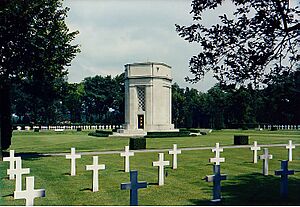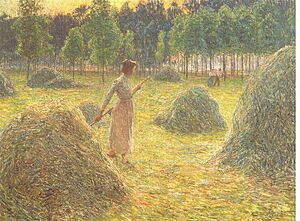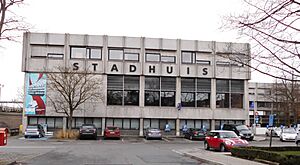Waregem facts for kids
Quick facts for kids
Waregem
|
|||
|---|---|---|---|

City parish church located on the marketplace
|
|||
|
|||
| Country | Belgium | ||
| Community | Flemish Community | ||
| Region | Flemish Region | ||
| Province | West Flanders | ||
| Arrondissement | Kortrijk | ||
| Area | |||
| • Total | 44.34 km2 (17.12 sq mi) | ||
| Population
(2018-01-01)Lua error in Module:Wd at line 1575: attempt to index field 'wikibase' (a nil value).
|
|||
| • Total | Lua error in Module:Wd at line 1,575: attempt to index field 'wikibase' (a nil value). | ||
| Postal codes |
8790-8793
|
||
| Area codes | 056 | ||
| Website | www.waregem.be | ||
Waregem (pronounced WAH-ruh-gem) is a cool city in Belgium. It's located in the West Flanders province. You can find it in the valley of the Leie River, right between the cities of Kortrijk and Ghent.
Waregem is part of the Kortrijk area. It includes a few smaller towns: Beveren, Desselgem, Sint-Eloois-Vijve, and Waregem itself. In 2019, about 38,260 people lived here. The city covers an area of 44.34 square kilometers. This means about 863 people live in each square kilometer!
Contents
History of Waregem
Early Days
People first settled in this area a very long time ago. They lived along the Leie River even before the Roman Empire. We know this because old bronze coins and tools from the Gallo-Roman culture have been found here. This shows that people were very active in this area during the first centuries AD.
One reason for this activity was that Sint-Eloois-Vijve was a busy crossroads. Two important Roman roads met there: one from Cassel to Tongeren, and another from Bavai to Oudenburg. The name "Waregem" itself might come from a group of people called the "Waro" clan. They might have lived here during the time of the Franks.
The Middle Ages
In the 900s, much of Waregem's land was given to the St Peter Abbey in Ghent. The Benedictines, a group of monks, used a local building near the Leie River as their main office. This building is still called the Munkenhof today.
Later, around the year 1000, Baldwin IV, Count of Flanders, used this area as a base. From here, he could plan attacks against Kortrijk. Over the next few centuries, land was divided among many different owners. These owners came from places like Dendermonde and Tournai.
Most people living in Waregem back then were farmers, spinners, and weavers. Tax records from the 1200s show that the area was very busy economically. Waregem tried to get permission to hold its own market in 1635, but nearby towns didn't want that. Finally, in 1784, Joseph II of Austria allowed Waregem to have a Saturday market.
From the 1700s to Today
The way land was owned didn't change much until the late 1700s. At that time, about 4,500 people lived in Waregem. A new main road was built between Kortrijk and Ghent. This led to a large inn being built in Waregem. Travelers could rent horses there.
The French Revolution brought big changes. It placed strict rules on religion. But it also gave the region a modern way of governing and more freedom. In the 1800s, the old cloth-making industry started to decline. However, the nearby Leie River was very helpful for Waregem. Its flax industry became very important. Flax is a plant used to make linen. This industry helped the local economy grow well into the 1900s. Waregem officially became a city on January 1, 2000.
Cool Places to See
- The Flanders Field American Cemetery and Memorial is a special place. It's the smallest American cemetery in Europe from World War I. It's also the only one in Belgium. Here, 368 American soldiers who died fighting to free Belgium in World War I are buried. A chapel there lists the names of 43 soldiers who went missing and were never found.
- There's a beautiful 8-hectare park around the Baron Casier castle. It's right in the middle of the city. The park has old trees, ponds, and fountains.
- Waregem also has several old churches and farm buildings. Some of them date back to the Middle Ages.
- The Gaverbeekhippodroom is one of the few horse racing tracks in Belgium.
Sports and Events
- Waregem is famous for its yearly horse races at the local hippodrome. This includes the exciting Great Flanders Steeple Chase. It happens on the first Tuesday after the last Sunday in August. This week-long event started in 1847 and is known locally as the Waregem Koerse.
- Waregem is the home of the former football (soccer) team K.S.V. Waregem. It's also where the current team S.V. Zulte-Waregem plays.
- The town is the finish line for the famous Dwars door Vlaanderen (which means Across Flanders) road bicycle race. Waregem was also the starting point for the third stage of the 2007 Tour de France. That race went from Waregem to Compiègne.
- The Cyclocross Masters, the final race of the cyclo-cross season, has been held in Waregem since 2013.
- Waregem also has its own rugby team, rugbyclub Waereghem.
Famous People from Waregem
- Aborted: A Death Metal band that started in 1995.
- Emile Claus: A famous painter (1849–1924).
- Ann Demeulemeester: A well-known fashion designer (born 1959).
- Erik Derycke: A politician, lawyer, and former government minister (born 1949).
- Dick Norman: A professional tennis player (born 1971).
- Jan Pieter Schotte: A cardinal and official in the Roman Curia (1928–2005).
- Franky Vandendriessche: A football goalkeeper (born 1971).
- Peter Vermeersch: A composer, clarinet player, and producer (born 1959).
- Marc Waelkens: A professor of archaeology (born 1948).
Sister Cities
Waregem has special connections with other cities around the world. These are called "twin cities" or "sister cities."
Euro Equus Cities
Waregem is also part of a group called "Euro Equus." These are cities that have a strong connection to horses.
See also
 In Spanish: Waregem para niños
In Spanish: Waregem para niños









